Tumbler Ridge, B.C. —
The company produces coal classified as PCI (pulverized coal injection), which has low sulphur and ash content and is used in place of more-expensive coking coal in steel production.
Already, a 102-car trainload has been shipped to Ridley Terminals at the northern port of Prince Rupert. This initial shipment is headed to
“We’ll be setting up arrangements with a number of different customers in Asia and Europe,” says WCC President Gary Livingston. “Posco is a key player, but there will be other steel mills. Roughly two-thirds of our product will be shipped to Asia; the remainder, to Europe.”
The capital cost of developing the Dillon mine was about $7 million, and salable reserves are pegged at 1.6 million tonnes. Coal mined from the Dillon open pit is trucked 94 km to the Bullmoose load-out facility under a multi-year agreement with
WCC is completing a 10-year agreement with Ridley Terminals to provide services through its bulk coal-handling facility. Twelve million tonnes are capable of being shipped from the terminal per year, and there is potential for doubling this capacity. In addition, Ridley has a stockpile capacity of 1.2 million tonnes.
Dillon’s reserves are in two separate seams, an upper and a lower, which have a relatively low waste stripping ratio of 2.2-to-1. The upper seam averages 2.4 metres in thickness with a 9.5% ash content. The lower seam, which contains most of the reserves, averages 5.2 metres and has a low ash content of 3.4%. The seams are mined separately and can be blended to produce the desired product, depending on the requirements of customers.
Initially, up to 60,000 tonnes per month are being mined on a contract basis. WCC currently has a small-mine permit for 250,000 tonnes annually but will be applying to increase this rate.
Adjacent to Dillon is the Brule deposit, which has historic reserves of 32 million tonnes, based on work carried out by Teck in 1981. Production from Brule is anticipated for 2006 to the tune of 1.5 million tonnes of PCI coal annually.
About 50 km southeast of Burnt River — between the dormant Bullmoose and Quintette mines — sits WCC’s Wolverine project, which comprises three deposit areas: Perry Creek, Mount Spieker/ EB Trend, and Hermann. Drilling, trenching and underground development (adits) have outlined a proven and probable resource of 49.3 million tonnes in the Perry Creek and EB Trend. The amount of run-of-mine coal recoverable from these areas is estimated to be 25.2 million tonnes, from which 15.6 million tonnes of clean metallurgical coal could be derived.
Development at Wolverine is expected to start in mid-2006. The mine will produce hard coking coal at an initial annual rate of 1.6 million tonnes, eventually rising to 3 million tonnes, says Livingston.
Meanwyhile, WCC and partner
In October 2004, WCC added a London Stock Exchange Alternative Investment Market (AIM) listing for its securities, in conjunction with a $20-million private placement financing. AIM-listed and London-based mining finance and investment house
WCC has 55 million shares outstanding and a capitalization of $350 million. At presstime, the stock was trading at $6.40.


Be the first to comment on "Western Canadian Coal revs up Dillon"